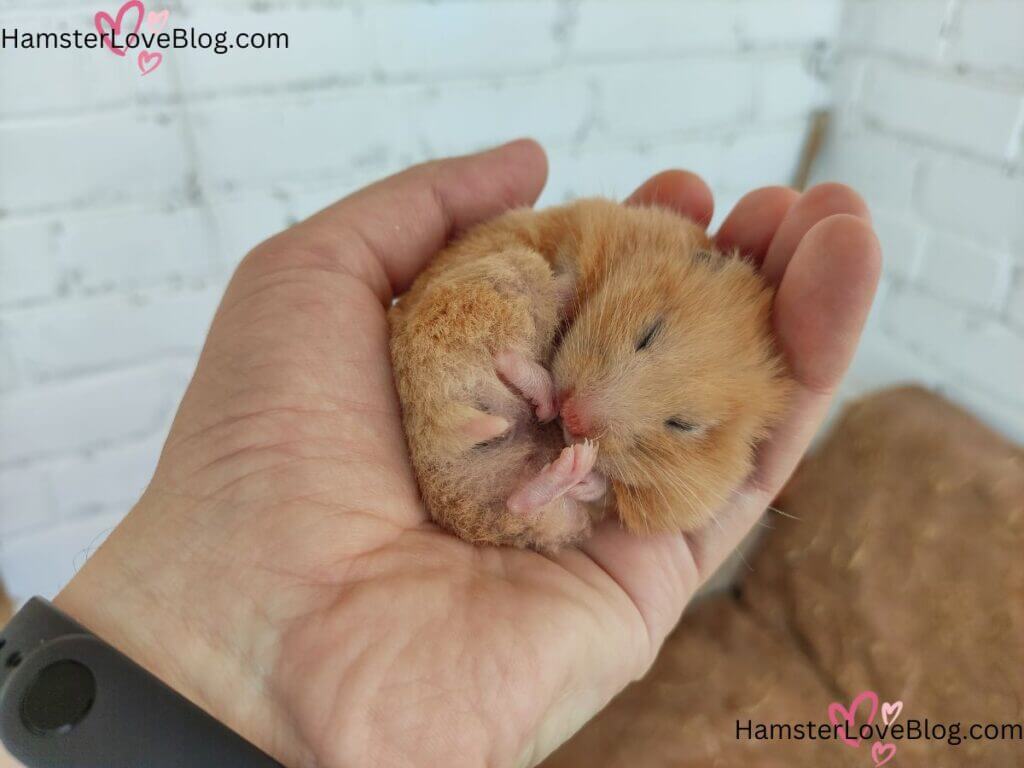
Have you ever watched your hamster nestle into its cozy bedding during the day and wondered, “Why does my little friend sleep so much?” It’s a common question that sparks curiosity in many hamster owners. Despite their small size and seemingly endless energy, hamsters are known for their extensive napping habits.
In this article, we will delve into the fascinating world of hamster sleep patterns. From understanding what’s typical for these nocturnal creatures to unraveling potential reasons behind excessive snoozing, we’ll explore every fluffy detail.
Join us on this journey as we uncover why your furry companion spends so much time dozing off, and what it means for both their health and happiness. Stay tuned—you might just discover new ways to enhance your bond with your sleepy buddy!
Understanding Hamster Sleep Patterns

Hamsters are known for their erratic sleep patterns, often leading new pet owners to wonder why these tiny creatures seem to snooze so much. On average, hamsters typically sleep between 12-14 hours a day. Unlike humans, they don’t consolidate all this rest into one long stretch but instead divide it into several shorter naps taken throughout the day and night. This polyphasic sleep pattern can be quite the spectacle as your hamster might appear alert and active one moment and then drift off into a dreamy slumber minutes later.
Several factors influence a hamster’s sleeping habits, including their natural instincts and immediate environment. These nocturnal animals are programmed to be most active during the twilight hours of dawn and dusk—an evolutionary trait that helps them avoid predators in the wild. This intrinsic behavior is often mirrored in domesticated hamsters who prefer to engage in energetic activities when household lights dim down and things grow quieter. Therefore, if your pet seems particularly lethargic during the daytime, it’s merely following its biological design.
Comparing wild and domesticated hamster sleep cycles reveals some intriguing differences and similarities. In their natural habitat, wild hamsters must stay vigilant for threats while scavenging for food at night; consequently, they adopt lighter and more fragmented sleep patterns to quickly respond to danger.
Domesticated hamsters retain these survival instincts but enjoy more security in captivity, allowing them deeper and sometimes longer periods of uninterrupted rest. However, both sets of hamsters share an innate ability to adapt their routines based on external stimuli such as light exposure or noise levels around them—a fascinating element that underscores just how closely linked our furry friends remain to their wild origins even as beloved household pets.
Reasons Behind Excessive Sleeping Behavior
Several factors might explain why your hamster is sleeping more than usual, and understanding these potential reasons can help you ensure their well-being. One common reason for increased sleep is the natural aging process. As hamsters get older, they tend to require more rest and may not have the same energy levels as when they were younger. If your once energetic pet starts to slow down and nap more frequently, it could simply be a sign of them gracefully entering their senior years.
Environmental factors also play a significant role in influencing your hamster’s sleep patterns. The habitat you’ve set up for your little friend should mimic their natural environment as closely as possible to promote healthy activity levels and regular sleep cycles. Temperature fluctuations or excessive noise can lead to stress and longer periods of sleep as a coping mechanism. Make sure their enclosure is kept in a calm, quiet area away from direct sunlight or drafty windows to create an ideal resting space.
Furthermore, diet and health significantly impact how much time your hamster spends snoozing. A poor diet lacking in essential nutrients can make them lethargic and less active during their waking hours. Ensure you’re providing a balanced mix of seeds, fruits, vegetables, and proteins appropriate for your species of hamster. Similarly, underlying health issues such as respiratory infections or dental problems could cause discomfort that leads to increased sleep as your pet conserves energy to heal. Regular vet check-ups are crucial for early detection and management of any potential health concerns that may be disrupting their normal routines.
By paying close attention to these aspects—age, environment, diet, and overall health—you can better understand the reasons behind your hamster’s extended naptimes and make informed decisions to support their lively nature whenever they’re awake.
Signs of Concern: When to Seek Help

While it’s normal for hamsters to spend a significant amount of time sleeping, there are certain signs that may indicate something more serious is at play. One major red flag is if your hamster suddenly starts sleeping much more than usual or displays a drastic change in its sleep cycle. Health issues like respiratory infections, nutritional deficiencies, and even stress can manifest as increased sleep. If your normally active pet seems lethargic or doesn’t respond to stimuli during its awake periods, it might be time to start paying closer attention.
Consulting a veterinarian becomes crucial when abnormal sleeping patterns are coupled with other worrying symptoms. For example, look out for noticeable weight loss, changes in eating habits, labored breathing, or visible discomfort. These indicators often suggest an underlying health issue that requires professional diagnosis and treatment. Early intervention not only helps maintain your hamster’s well-being but also prevents minor conditions from escalating into serious problems.
Monitoring changes in behavior is key to ensuring your hamster remains healthy and happy. Keep a detailed log of its sleep habits over the course of a week— noting times it wakes up, naps you observe during daylight hours, and overall activity levels. A sudden shift in these patterns should prompt a closer inspection of their habitat and lifestyle. Ensure the environment is stress-free and enriched with activities that provide mental stimulation—such habits encourage balanced wakefulness and rest cycles.
Involving the entire family in this monitoring process can make it easier to spot subtle changes early on. Engage children or other household members in regular playtime sessions with your hamster; this interaction not only strengthens the bond between pet and owner but also promotes healthier sleep patterns by encouraging natural wakeful activities.
Managing Excessive Sleeping in Hamsters
Creating an enriched environment is essential to prevent your hamster from oversleeping and ensuring it leads an active, healthy life. Begin by providing a variety of toys and accessories that stimulate mental and physical activity. For instance, tunnels, chew toys, wheels, and climbing platforms can significantly contribute to keeping your furry friend engaged during its wakeful hours. Rotate these toys periodically to keep the environment refreshing and exciting for your hamster.
Playtime and exercise are crucial components of maintaining a balanced rest schedule for your pet. Hamsters are naturally curious creatures that enjoy exploring their surroundings. Setting aside time each day for supervised play outside the cage offers great exercise and prevents boredom—a common contributor to excessive sleeping. Creating obstacle courses with various textures and items allows hamsters to exhibit natural behavior like burrowing, climbing, and running.
Regulating light exposure plays a critical role in managing a hamster’s sleep quality. As nocturnal animals, hamsters thrive on a consistent cycle of darkness during the day and dim lighting at night to mimic their wild habitat conditions. Ensuring minimal noise levels around their living space also contributes positively to their well-being. Loud sounds or sudden disruptions can disturb your hamster’s sleep patterns, leading them to rest more frequently throughout the day out of stress or exhaustion.
By fostering an engaging environment tailored to your hamster’s natural habits, you promote healthier sleep cycles and enhance overall well-being for your tiny companion. Observing how it interacts within this stimulating setting can provide further insights into adjusting their routine optimally, ensuring they remain both active and rested appropriately.
Encouraging Natural Behaviors: Mimicking Wild Habits
To help your hamster stay more active and engaged, it’s essential to incorporate activities that mimic their natural behaviors in the wild. In their native habitats, hamsters spend much of their waking hours foraging for food, tunneling, and exploring varied terrains. Replicating these behaviors can be as simple as introducing a variety of substrates and hiding places within their enclosure. For instance, you could provide materials like paper towel rolls or sand to encourage burrowing and digging, which not only stimulates physical activity but also mental enrichment.
Interactive toys and DIY enrichment activities can significantly enhance your hamster’s awake time by providing challenges that cater to their instincts. Puzzle feeders filled with small treats or scatter feeding peppered with hidden snacks around the cage can emulate the foraging experience they naturally crave. Additionally, exercise wheels are a staple; opting for silent models can allow them to stay active without disturbing the household during nighttime spurts of energy. Consider incorporating items such as climbing structures or multi-level cages to introduce new dimensions of exploration.
Creating a routine that mirrors a hamster’s instinctual tendencies involves recognizing their crepuscular nature—they’re most active during dawn and dusk. By aligning playtime sessions with these peak activity periods, you ensure that your hamster is up and about when you’re available to interact with them. This approach not only reinforces natural sleep-wake cycles but also strengthens the bond between you and your furry friend through shared experiences during optimal windows of alertness.
Encouraging these instinct-driven activities doesn’t just curb excessive napping; it enriches your pet’s life by tapping into their innate behaviors. A well-stimulated hamster enjoys an environment that fosters curiosity and engagement while enhancing overall well-being. Through thoughtful adjustments and creative solutions, you enable a harmonious balance between rest and activity crucial for maintaining a healthy, contented companion.
Enhancing Your Bond with Your Slumbering Friend
Understanding why your hamster sleeps so much is crucial in ensuring their well-being. We have explored typical sleep patterns, the reasons behind excessive snoozing, and when it might be time to consult a vet. By offering enrichment, regulating environment conditions, and encouraging natural behaviors, you can help balance your pet’s rest and activity.
Patience and observation are key. Take the time to monitor changes in your hamster’s sleep habits and overall behavior. This will foster a healthier relationship between you and your furry friend. Dive deeper into the fascinating world of animal behavior; it’s a journey that enriches both you and your pet.





